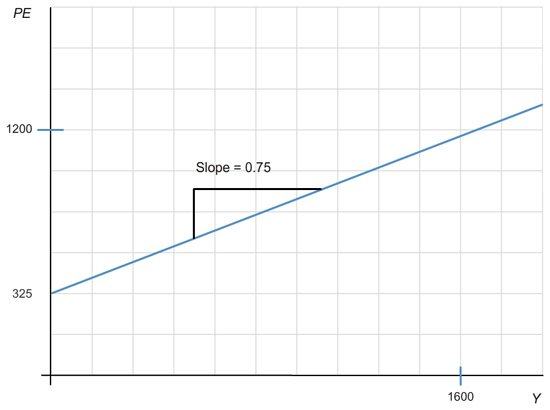Question 1 of 3
Step 1
In the Keynesian cross model, assume that the consumption function is given by
C = 200 + 0.75 (Y – T).
Planned investment is 100; government purchases and taxes are both 100.
a & b. Below is a graph of planned expenditure as a function of income. What is the equilibrium level of income?

Y =
- Chapters
- descriptions off, selected
- captions settings, opens captions settings dialog
- captions off, selected
- English Captions
This is a modal window.
Beginning of dialog window. Escape will cancel and close the window.
End of dialog window.
This is a modal window. This modal can be closed by pressing the Escape key or activating the close button.
This is a modal window.
Step 2
In the Keynesian cross model, assume that the consumption function is given by
C = 200 + 0.75 (Y – T).
Planned investment is 100; government purchases and taxes are both 100.
c. If government purchases increase to 110, what is the new equilibrium income? What is the multiplier for government purchases?
Y =
Multiplier =
- Chapters
- descriptions off, selected
- captions settings, opens captions settings dialog
- captions off, selected
- English Captions
This is a modal window.
Beginning of dialog window. Escape will cancel and close the window.
End of dialog window.
This is a modal window. This modal can be closed by pressing the Escape key or activating the close button.
This is a modal window.
Step 3
In the Keynesian cross model, assume that the consumption function is given by
C = 200 + 0.75 (Y – T).
Planned investment is 100; government purchases and taxes are both 100.
d. What level of government purchases is needed to achieve an income of 1,420? (Taxes remain at 100.)
G =
e. What level of taxes is needed to achieve an income of 1,420? (Government purchases remain at 100.)
T =
- Chapters
- descriptions off, selected
- captions settings, opens captions settings dialog
- captions off, selected
- English Captions
This is a modal window.
Beginning of dialog window. Escape will cancel and close the window.
End of dialog window.
This is a modal window. This modal can be closed by pressing the Escape key or activating the close button.
This is a modal window.